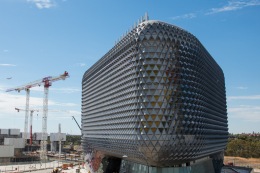29 November 2013
 As the red carpet is rolled out for the opening of the South Australian Health and Medical Research Institute, the University of South Australia will be preparing to consolidate its population health research in the new facility at the heart of a dynamic new North Terrace health precinct.
As the red carpet is rolled out for the opening of the South Australian Health and Medical Research Institute, the University of South Australia will be preparing to consolidate its population health research in the new facility at the heart of a dynamic new North Terrace health precinct.
University of South Australia Vice Chancellor Professor David Lloyd says the decision to invest in health and medical research at the size and scale of the Institute will allow unprecedented collaboration in the State in internationally significant research.
“The breakthroughs and gains made at the Institute will be vital to Australian leadership in health sciences research and we are delighted to be one of the partners in this major health enterprise,” Prof Lloyd says.
As the only university in the State to co-locate a whole school in the new building, Prof Lloyd says UniSA hopes to lead a dynamic approach to population health research at the Institute.
The School of Population Health has a team of researchers looking at the social determinants of health including factors such as the social, environmental, cultural and physical aspects populations are born into, grow up in and function with throughout their lifetimes which potentially have a measurable impact on health.
Complementing the characteristics of mainstream medical research with its focus at the individual level, population health addresses a broader range of factors that are shown to impact the health of different populations.
Researchers work using sophisticated analysis techniques to track defined groups over time and measure health outcomes such as the rates of cancer morbidity, obesity, heart failure or stroke in different groups.
“Population health research allows us to see patterns in health and well-being and works to identify points of opportunity where policy interventions can make a difference. So not only does it build a case for health interventions, it also supports the better management of health expenditure and resources – issues that will be of increasing significance for the nation as our population ages and changes,” Professor Lloyd says.
“The research relationships forged in SAHMRI have the potential to be world beating in their dynamism.
“SAHMRI will house a network of more than 600 researchers who will, every day, have opportunities to cross reference, learn from each other and share their understandings allowing them to leap across the traditional boundaries that sometimes apply in research communities.
“All three universities will be represented as will researchers from our key hospitals and new researchers from around the world who have been drawn to work here by the sheer potential of this new Institute.”
Professor Lloyd congratulated the State and federal Governments for their vision in investing in SAHMRI.
He said the University would be maximising the potential of SAHMRI not only by becoming a vibrant player in the institute but also by making the most of the broader North Terrace Health precinct as it emerges.
“Our plan to build a new Centre for Cancer Biology will further boost research capacity in what promises to be one of the most amazing research and innovation communities in Australia,” Prof Lloyd says.
Media contact: Michèle Nardelli office: 08 8302 0966 mobile: 0418 823 673 email: Michele.nardelli@unisa.edu.au


